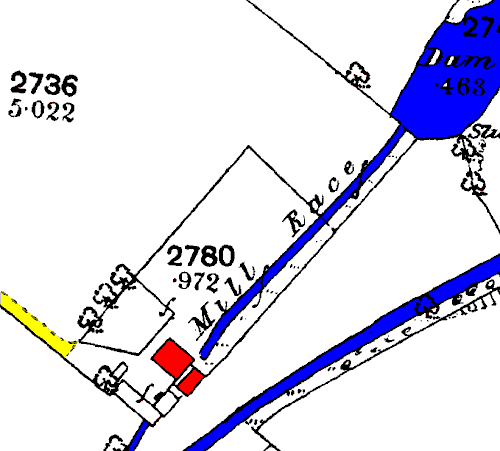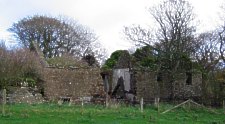
From 1868 O/S Plan XVI.8 - SC 275696

as seen c.1990
|
|
|
The start of this Mill to drive several cotton spinning machines is the agreement between Deemster Moore and DelaPryme & Wheelhouse in SSS May 1782 98
dated 12 Jan 1780;(Long) Indenture between Deemster Thos Moore + wife Margaret and Abraham DelaPryme + Francis Wheelhouse (late sheffield) cotton spinners;Moore to sell for 10s a small field (1 acre)wherein the dam for the works intended to be made, now in possession of John Schofield & also the field being now under wheat adj 1st field on south west containing 1.25ac whereon the intended mill to be erected - both fields abbey demesne - Thos Moore to erect + build walls for a mill 34ft long x 26ft broad within and 30ft high - Moore to find slates, mortar + workmanship for roofing + mill to be plastered + also make road to mill;Delapryme + Wheelhouse to find, procure + prepare timber etc + also make a weir, damhead + shuttle - Delayprymme + Wheelhouse may quarry stone on Moore's land for repairs etc + to use Moore's lime kiln;Moores to receive annual rent £12 12s brit paid half yearly commencing 10 april 1781 + to maintain windows etc - if rent in arrears by 3mnths Moore to repossess;witt Mark Wilks, Charles Moore, Ann Barker + James Delapryme;abbey quest set rent 6.5d;
A later sale was noted in SSS May 1787 81
dated 31 Dec 1784;Deemster Thos Moore + wife Margt sell for 1s to Abraham Delapryme(gentleman) a parcel of land (2.5ac) adj road to Cotton Mill on west and south, cotton mill race on east and Moore's lands on north wheron a dwelling house + other edifices to be erected by Delapryme who is to pay annual rent £3 18s 9d Brit half yearly;witt James Wilks, James Wood;signed + sealed;ack'd 25 Nov 1786;abbey quest set 7d rent
The mill had a short 20 year life before running foul of English customs - see also under Industrial Archaelogy.
The mill would appear to have been re-purposed as a flax mill as Cumming writing of a geological study along the Silverburn - "The flax-mill forms a picturesque object in the nearer landscape, and we just hear its monotonous sound floating down to us upon the streamlet and the breeze. The discharged water from the wheel, as it rushes from the conduit into the Silverburn below, raises many a bright bursting bubble to the surface, and attracts around its embouchere a shoal of sportive trout."
After the flax mill closed there are records of the water wheel powering a threshing machine.
IAIoM notes that "decay has accelerated since 1965" which is when a survey of surviving industrial sites was undertaken. Sixty year later a few walls are still just about standing
C Aspin The Water Spinners Helmshore Local History Society 2003 (ISBN 0 906881 11 0)
[IAIoM]T.A.Bawden, L.S. Garrad, et al The Industrial Archaeology of the Isle of Man Newton Abbot: David & Charles 1972 (ISBN 0-7153-5440-X)
|
|
||
| Water powered Mills etc | ||
|
|
||
|
Any comments, errors or omissions gratefully received The
Editor |
||